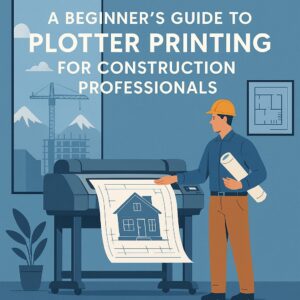Why Colorado Construction Firms Are Switching to Wide Format Plotters
The Skinny
Construction firms and architectural companies across Colorado are increasingly embracing wide format plotters to stay competitive. With in‑house control over printing, faster project turnaround, and reduced costs, plotters aren’t just a “nice to have”—they’re becoming essential. In this post, you’ll learn:
-
What a wide format plotter is and how it differs from standard printers
-
Why plotters are being adopted in construction / AEC (architects, engineers, contractors) especially here in the Front Range
-
Key features to look for in a plotter when purchasing for construction workflows
-
Estimated cost savings vs outsourcing plans + reuse + fewer errors
-
A comparison chart of what specs matter most + sample models
-
How you can move forward with ABT: demos, financing, tips for getting started
What Exactly Is a Wide Format Plotter?
A wide format plotter (or printer) is a specialized printer that can handle large media—typically widths 24″, 36″, 44″, 60″, and even up to 64″ or more. They are designed for:
-
Printing large‑scale technical documents (blueprints, site drawings, CAD / Revit / structural plans)
-
Rendering maps, topographical layouts, architectural elevations
-
Producing signage, renderings and client presentation boards
-
Reprinting revisions fast without outsourcing
Unlike standard office printers, plotters are built to maintain precision (very accurate line thickness, scaling, etc.), support specialty media or durable paper, and handle large rolls or sheets reliably.
Why Construction & Architecture Firms in Colorado are Making the Switch
Here are the major reasons firms in Denver, Colorado Springs, Fort Collins, Boulder, and other Front Range cities are investing in wide format plotters:
-
Accuracy and Precision are Non‑Negotiable
Construction documents must be exact. Any error in measurements or unclear line work can lead to field mistakes, rework, or costly delays. Wide format plotters produce crisp, clean lines and scale accuracy so that contractors, surveyors, and architects see exactly what’s on screen. -
Reduced Turnaround Time = Faster Project Delivery
Outsourcing large prints often introduces delays—job shops busy, delivery or pickup times, overnight or longer waits. With an in‑house plotter, you control your schedule. Revisions go from designer to print in hours not days. When deadlines are tight (permit submissions, bidding, field changes), that speed advantage shows up in profitability (and reputation). -
Cost Savings Over Time
While acquiring a plotter is an investment, over time you avoid repeated outsource fees, shipping, markup, and last‑minute rush charges. Plus, fewer mistakes because you can review proofs quickly, trim errors early, and avoid shipping damages. -
Better Control Over Revisions
Construction projects often involve changes: redlines, markups, field revisions. With a plotter on‑site, you can print revised sheets immediately rather than sending files out, waiting, then integrating delivered prints. -
Enhanced Professionalism & Visual Impact
When presenting plans to owners, municipal agencies, or clients, having your own crisp, large format prints adds credibility. Color renderings, presentation boards, signage from your shop—these elevate perception and can improve trust in bidding or permitting processes. -
Versatility in Materials & Environment
Construction firms often need prints that survive rough environments—site offices, trailers, job sites—signs, temporary fences, banners, permits, and protective wraps. Wide format plotters often support durable materials, weather‑resistant inks, and robust media handling to adapt to Colorado’s variable climate (sun, snow, heat).
What to Look for When Choosing a Wide Format Plotter for Construction Use
Not all plotters are equal. Here’s a checklist of features that matter the most for AEC & construction firms, especially in Colorado.
| Feature | Why It Matters |
|---|---|
| Print Width / Roll Capacity | Determines how large your plans or drawings can be; full sheet sizes, borderless when needed; roll capacity reduces media handling. |
| Resolution & Line Accuracy | Fine lines, small text, symbols must be clear; affect readability on different site lighting. |
| Fast Print Speed + Warm‑Up Time | Jobs often run under tight schedules; speed and minimal delay from idle state help. |
| Durable Media & Ink Options | Weather‑resistant, fade‑resistant, tear‑resistant; durable inks / UV or solvent with coatings are helpful outdoors. |
| Revisions / Markup Handling (Scanner / Copier / Integration) | Ability to scan printed markups or work with cloud / plan‑room tools; printers that integrate well with AutoCAD / Revit / Bluebeam reduce friction. |
| On‑site Service & Local Support | Being located near Denver / Colorado Springs helps reduce downtime and shipping / repair delays. |
| Operational Cost (Ink, Media, Maintenance) | Need to account for consumables, replacement parts, energy consumption; look for models with lower cost per square foot for your typical usage. |
Comparison Chart: Specs That Matter + Sample Model Considerations
Here’s a table showing key specs to compare and what you might target.
| Spec | Entry / Smaller Firms | Mid‑Sized Firm / Mixed Use | High Output / Frequent Revisions |
|---|---|---|---|
| Print Width | 24‑36″ rolls | 44‑60″ roll & some sheet functions | 60‑64″ rolls, dual roll, large sheet or board capability |
| Resolution (dpi) | 600‑1200 | 1200‑2400 | 2400 or more, especially for renderings |
| Media types handled | Bond paper, vellum, lightweight plot paper | Coated paper, canvas, vinyl, laminated board | Specialty media, weatherproof, heavy boards, backlit materials |
| Throughput / Speed | Moderate (few prints/day) | High (many prints/week) | Very high, many daily revisions, multiple sets |
| Color vs B&W print | Mostly B&W with occasional color | Balanced color & B&W | High volume color + presentation boards |
| Integration & Software | Basic drivers, maybe Cloud | BIM / CAD / Bluebeam compatibility | Full integration, scanning, markups, digital workflows |
Local Considerations for Colorado Construction Firms
Because life in Colorado brings specific challenges, here are some additional factors firms here should watch:
-
Climate & Weather: Sun exposure, UV, cold/hot cycles may fade or damage prints; choose inks & materials rated for local conditions.
-
Altitude & Dry Air: Affects media handling; curl, static—machines that have humidity control, good roll tension, media drying are helpful.
-
Turnaround Demand / Permitting Schedules: Local jurisdictions often require physical plan prints for permit submittal; missing deadlines can stall job sites. Quick in‑house access helps.
-
Local Service / Media Supply: Access to media suppliers, toner / ink resellers, and reliable parts is better in Denver / Front Range. ABT’s local service network helps reduce down/unplanned delays.
Cost vs Outsourcing: Financial Impact
Let’s do a rough comparison to show when buying a plotter tends to pay off vs outsourcing. (Numbers illustrative; you’ll want to use your own usage volume.)
| Scenario | Outsourcing Cost | In‑house Cost with Plotter | Break‑Even Timeframe* |
|---|---|---|---|
| 50 large blueprint sets / month | Pay print shop per set + delivery / rush fees | Own printer + media + maintenance + labor | ~ 6‑12 months |
| Frequent revisions (redline, last minute) | Re‑print costs, shipping delays, idle staff waiting | Immediate print/print own sets as needed | Even quicker, maybe 3‑6 months if many revisions |
| Signage / onsite banners | Outsource signage, shipping, markup | In‑house ordering, bulk media costs, faster reprints | Year 1 savings become significant |
*Depends on your firm’s volume, cost of outsourcing locally, staff time, media costs.
Overcoming Concerns & Common Objections
Here are some common concerns firms have, and how to address them:
-
“Plotters are expensive / big investment.”
Answer: Consider lease financing, look for models with lower maintenance, use ROI calculators. Even moderate volume plans can pay for themselves within a year or two if you print frequently. -
“We’ll have lots of maintenance / downtime.”
Answer: Choose models with strong local support, maintenance contracts, good warranties, and plan for preventative maintenance. ABT offers onsite or rapid response support locally. -
“We don’t print enough volume to justify owning one.”
Answer: Calculate actual prints per month, including revisions. If you outsource often or need prints at last minute, those costs + delays often add up more than you think. -
“Media and consumables costs are unpredictable.”
Answer: Buy media in bulk, choose reliable vendors, get cost per square foot estimates, and ensure ink/media are well matched to usage. Use vendor demo units to test media to avoid waste.
Upgrade Your Plotting Capabilities Now
If your construction or architecture firm is still outsourcing large prints, waiting for revisions, or losing time and control, now is a smart moment to move in‑house. Here’s how ABT helps:
-
Free consultation and print volume audit: we’ll help you estimate real cost vs your outsourcing bills
-
Local demos: see clarity, size, durability, and media types in person
-
Flexible purchasing or leasing options to suit Q4 budgets
-
Warranty and service plans to keep your plotter working reliably at job sites

